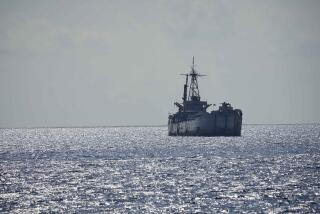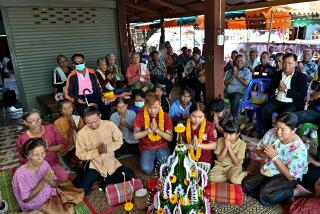Hostage Survivor Backs Manhunt
- Share via
MANILA — Kansas missionary Gracia Burnham, who lost her husband and a year of her life as a hostage in the Philippine jungle, left for the United States today saying the Islamic rebels who kidnapped them “should be treated as common criminals.”
“During our ordeal, we were repeatedly lied to by the Abu Sayyaf, and they are not men of honor,” she told reporters at the Manila airport. “We support all efforts of the government in bringing these men to justice.”
Burnham and her husband, Martin, were kidnapped more than a year ago by the Abu Sayyaf. He was killed Friday and she was shot in the leg during a rescue attempt by the Philippine army that went awry. Hostage Deborah Yap, a Philippine nurse, also died.
Burnham, sitting in a wheelchair, appeared calm and relaxed, but her voice trembled at times as she read a statement to reporters.
“We especially want to thank the military men, the Americans, the Filipinos who risked and even gave their lives to rescue us,” she said. “Part of my heart will always stay with the Filipino people.”
With the death of Martin Burnham and Yap, the Philippine government has sworn to destroy the Abu Sayyaf gang, which has kidnapped dozens of people in the southern Philippines.
But as the Islamic extremist group has repeatedly proved, eradicating the rebels from the rugged islands where they enjoy popular support is no easy matter.
Since January, the United States has deployed more than 1,000 troops to the region to train and assist the Philippine army. Last month, the U.S. offered a $5-million reward for the capture of Abu Sayyaf leaders. The Pentagon has given the Filipinos sophisticated military equipment and used high-tech surveillance methods to track the rebels’ movements.
Yet even with U.S. military help, the Philippine army is no closer to crushing the Abu Sayyaf than it has been since the group was formed a decade ago.
On Sunday, Philippine troops were pursuing 50 members of the gang through the dense jungle of Mindanao island, but no sightings or clashes have been reported since the shootout Friday. Officials said the rebels had split up into small groups and escaped into the dense undergrowth after the battle in which Martin Burnham, Yap and four rebels were killed.
Officers initially said the two hostages were executed by the kidnappers. But Gracia Burnham has told relatives that they were shot in the cross-fire after Philippine troops attacked.
Frustrated Philippine soldiers had been trying to find and rescue the Burnhams and Yap since they were kidnapped. Critics questioned Sunday whether the $5-million reward for the Abu Sayyaf’s leaders had prompted the soldiers to become trigger-happy, leading to the two hostages’ deaths.
Burnham expressed no bitterness toward the soldiers. U.S. officials say they blame only the rebels and will not seek an inquiry into the deaths.
“It is clear to us Martin was killed by the Abu Sayyaf,” U.S. Ambassador Francis Ricciardone told reporters at the airport. “They are criminally culpable.”
Top Philippine officials were unwilling to discuss their strategy now in pursuing the Abu Sayyaf on Mindanao. But experience shows that the rebels are elusive and unpredictable jungle warriors who are likely to kidnap new victims as they travel.
Most recently, they were able to slip away last month from Basilan island, where the Philippine army believed it had them cornered. The rebels took their hostages on small fishing boats to much larger Mindanao despite a Philippine army cordon and U.S. surveillance flights.
Abu Sayyaf, which means “Father of the Sword,” was founded by Abdurajak Abubakar Janjalani, a Muslim who fought in Afghanistan against the Soviet Union and espoused the creation of an Islamic state in the southern Philippines. After he was killed by police in 1998, the group drifted from its Islamic dogma and became a brutal kidnap-for-ransom gang.
Until 1995, the group maintained links to Osama bin Laden, whose allies were active in the Philippines. Today, the U.S. government says the gang is still tied to Al Qaeda, although little evidence of a connection has surfaced publicly.
Before the Sept. 11 attacks and the start of the U.S. war against terrorism, Philippine President Gloria Macapagal Arroyo played down the group’s ideological roots and portrayed it as “a bunch of bandits.” But since the attacks on New York and the Pentagon, she has branded the group an international terror organization.
President Bush has given the Philippine government $100 million in aid to fight the rebels and sent the U.S. troops, including 160 Special Forces, to train and assist the Philippine army until July 31.
The Abu Sayyaf appears to be a loosely structured organization with separate forces operating under autonomous commanders on at least three islands. The main body of about 500 rebels is on Jolo island, about 60 miles from Basilan and Mindanao, the islands where the Burnhams were taken and where the U.S. troops are stationed. Authorities say at least 70 armed rebels remain on Basilan.
U.S. Maj. Richard Sater said that Friday’s rescue mission was conceived and executed entirely by the Philippine armed forces. After the firefight, U.S. helicopters helped evacuate Gracia Burnham, and U.S. military medics treated her wound, he said.
Although the U.S. troops in the southern Philippines are armed and may fire in self-defense, Philippine law prohibits them from engaging in combat operations.
“All we’re doing here until we depart at the end of July is advising and assisting them to hone their skills to combat terrorism,” said Sater, who is based in Zamboanga City on Mindanao island.
In particular, he said, the U.S. trainers are focusing on basic skills such as marksmanship and first aid.
Now, without any hostages in the picture, the dynamic of the government’s military operation has changed.
The rebels fleeing from the troops can no longer use the hostages as shields and will be more vulnerable to attack. At the same time, they will be able to move more quickly through the jungle and will be able to blend in with the local population. Indeed, if they stash their weapons and shed their camouflage uniforms, they will be all but indistinguishable from the island’s local population.
Since the death of the hostages, the Philippine army has poured thousands of troops into the area to search for the rebels. Regional military commander Maj. Gen. Ernesto Carolina declared, “We will not let them get away with this.”
More to Read
Sign up for Essential California
The most important California stories and recommendations in your inbox every morning.
You may occasionally receive promotional content from the Los Angeles Times.













